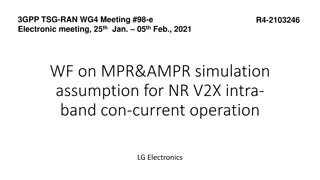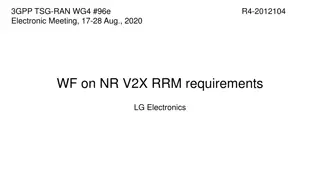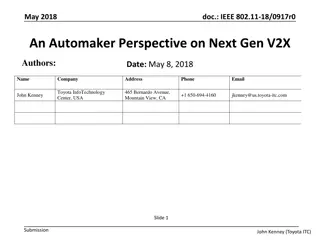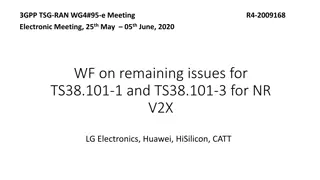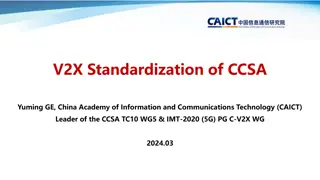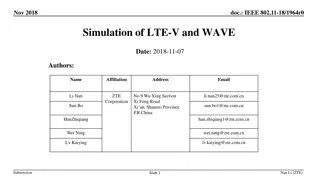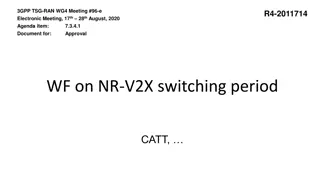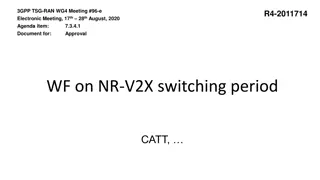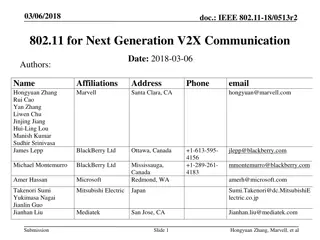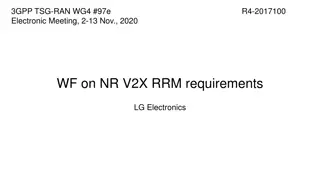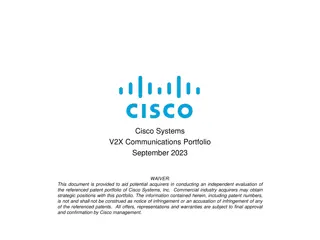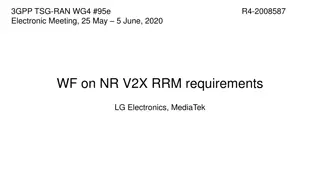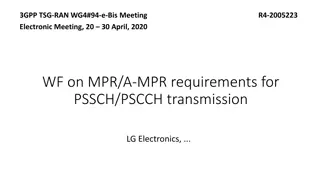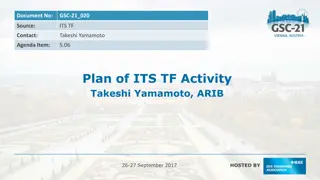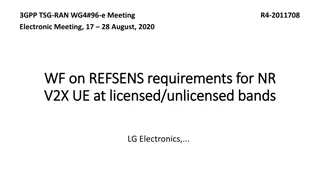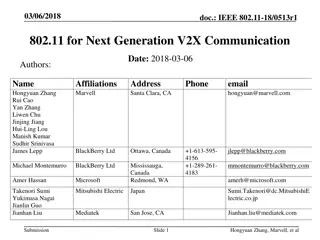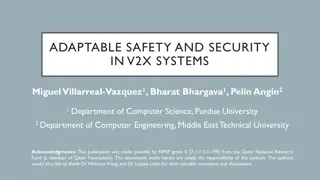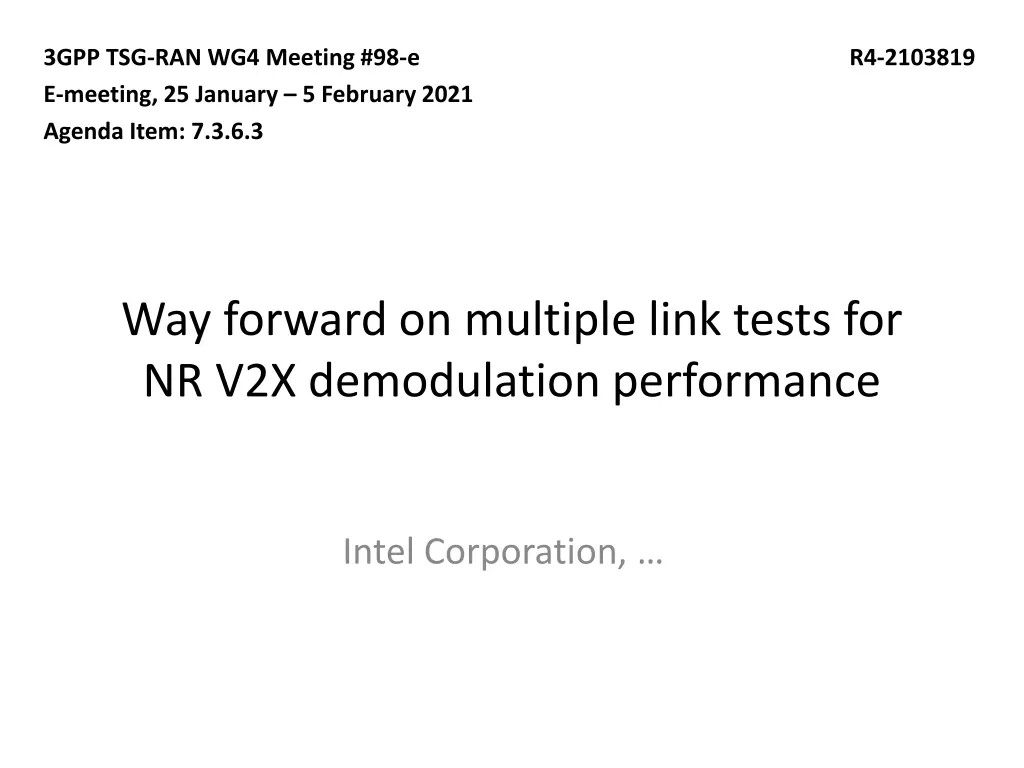
Agreements for RAN WG4 Meeting - January-February 2021 Agenda Items
Explore the agreements from the RAN WG4 Meetings, covering topics such as power imbalance requirements, HARQ buffer tests, PSFCH decoding, and more for NR V2X demodulation performance. Dive into methodologies, test designs, and performance metrics discussed in these important gatherings.
Download Presentation

Please find below an Image/Link to download the presentation.
The content on the website is provided AS IS for your information and personal use only. It may not be sold, licensed, or shared on other websites without obtaining consent from the author. If you encounter any issues during the download, it is possible that the publisher has removed the file from their server.
You are allowed to download the files provided on this website for personal or commercial use, subject to the condition that they are used lawfully. All files are the property of their respective owners.
The content on the website is provided AS IS for your information and personal use only. It may not be sold, licensed, or shared on other websites without obtaining consent from the author.
E N D
Presentation Transcript
3GPP TSG-RAN WG4 Meeting #98-e E-meeting, 25 January 5 February 2021 Agenda Item: 7.3.6.3 R4-2103819 Way forward on multiple link tests for NR V2X demodulation performance Intel Corporation,
Power imbalance requirements Agreements from RAN WG4 Meeting #97-e Methodology for NR V2X power imbalance test Reuse the methodology from LTE V2X power imbalance test PSSCH MCS 4 Test metric: PSSCH BLER 10% of Sidelink UE 2 Agreements for RAN WG4 Meeting #98-e ICS level: -27dBc Distance between the two links: 20 PRBs, UE1 PRBs 0-9, UE2 PRBs 30-39 SCI format 2-A configuration: Payload = 35 Bits, = 1, ??????? = 3.5. SNR UE1 = 30.35 dB 2
HARQ buffer soft combining test Agreements from RAN WG4 Meeting #97-e Test purpose The main test purpose is to verify HARQ buffer combining. Configuring of high MCS and long interval between transmission and retransmission is not precluded. Test design CBW: 20 MHz For verification of n16 and n24, 16 or 24 UEs transmit signal one by one circularly for every slot and in the first subchannel. For verification of n32, the first 31 UEs transmit signal one by one circularly for every slot and in the first subchannel. The 32nd UE transmit signal in the same slot as the first UE but in the second subchannel. For verification of n64, first 31 UEs transmit signal one by one circularly for every slot and in the first subchannel, the next 31 UEs transmit signal one by one circularly for every slot and in the second subchannel, the last 2 UEs transmit signal in the same slot as the first two UEs but in the third subchannel. Propagation conditions: AWGN channel model PSCCH resource allocation: 2 symbols and 10 RBs 2 DMRS symbols for PSSCH PSFCH configuration: PSFCH with periodicity 1 Test metric: 5% of PSSCH BLER 3
HARQ buffer soft combining test Agreements for RAN WG4 Meeting #98-e Test design for UE supporting n48 HARQ processes Add the following test to verify UE support receive 48 HARQ processes per slot: For verification of n48, the first 31 UEs transmit signal one by one circularly for every slot and in the first subchannel. The next 17 UEs transmit signal one by one circularly for every slot and in the second subchannel Sub-channel size: 10 PRBs SCI stage 2 configuration: Payload = 35 Bits, ??????? = 2.5 MCS MCS 20 Rx assumptions for simulation alignment Option 1: 600 Hz frequency offset and 12 Ts time offset Option 2: 0 Hz frequency offset and 0 Ts time offset Companies are encouraged to prepare link level simulation results for Option 1 and Option 2 in the next RAN4 meeting for scenarios with and without soft combining How to define the requirements for different supported max number of HARQ process One set of performance requirements based on the results of n64 4
PSFCH decoding capability test Agreements from RAN WG4 Meeting #97-e Test design N UEs transmit PSFCH one by one following procedure from Section 16.3 of TS 38.1213 N is {5, 15, 25, 32, 35, 45, 50, 64} depending on UE capability PSFCH periodicity 1 Feedback mode: ACK/NACK Propagation conditions Static propagation condition without external noise Test metric Pr(DTX to ACK)<1% and Pr(ACK miss)<1% Agreements for RAN WG4 Meeting #98-e CBW/SCS 40 MHz, 30 kHz Number of sub-channels Multiple subchannels of size 10 PRBs (i.e. 10 for 40 MHz case) 5
PSCCH/PSSCH decoding capability test Agreements from RAN WG4 Meeting #97-e DMRS configuration: 2 DMRS symbols MCS 4 Propagation conditions: Static propagation condition without external noise Test metric: Probability of missed PSCCH 1% Agreements for RAN WG4 Meeting #98-e CBW and feedback configuration Option1: No PSFCH, AT command and 40 MHz Option2: Using PSFCH with PSFCH with periodicity 1 and flexibly CBW depending on psfch-TxNumber capability: 40MHz channel bandwidth is for the UE supporting psfch-TxNumber =n16, 20MHz/30MHz channel bandwidth is for the UE supporting psfch-TxNumber =n8, and 10MHz channel bandwidth is for the UE supporting psfch- TxNumber =n4. Option 3: 40 MHz CBW, PSFCH based feedback and following test methodology TE sets PSSCH priority (in PSCCH) when PSFCH Tx capability < 10, x PSSCH with higher priority, 10-x PSSCH with lower priority. Note that PSFCH is selected according to PSSCH priority, hence if PSFCH Tx capability = x, the x feedback corresponding to x high priority PSSCH is transmitted to TE. TE can verify UE PSCCH decoding success or failure by checking whether all the higher priority PSSCH feedback is received. In order to always feedback all the high priority SCHs, UE has to decode all CCH to know the priority. To avoid UE cheating, TE can randomize the location of higher priority PSSCHs Companies are encouraged to analyze the pros and cons of each option for the next RAN4 meeting. Verification of 2*floor(NRB /10 RBs) capability Not to verify 2*floor(NRB /10 RBs) capability in Rel-16 V2X 6
SDR with active sidelink test Agreements for RAN WG4 Meeting #98-e Not define the SDR test cases with active sidelink in Rel-16 V2X WI. RAN4 also realize with such agreements, the co-current operation has not been verified by Rel-16 RAN4 demodulation requirements. RAN4 can further discuss and define corresponding test cases if needed in Rel-17 timeframe i.e. Rel-17 sidelink enhancement WI. 7

